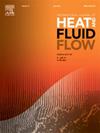Near-wall characteristics of non-equilibrium turbulent boundary layers on rough walls
IF 2.6
3区 工程技术
Q2 ENGINEERING, MECHANICAL
International Journal of Heat and Fluid Flow
Pub Date : 2025-07-11
DOI:10.1016/j.ijheatfluidflow.2025.109937
引用次数: 0
Abstract
Engineering models of rough-wall turbulent flows rely on reduced model of the near-wall layer of flow modified by roughness (i.e. the roughness sublayer) to provide boundary conditions to the flow above. Understanding sublayer response to pressure gradients and the pressure gradient history is crucial for developing physics-based turbulence closures. This work examines characteristics of the roughness sublayer using roughness-resolved simulation data of two flat-plate boundary layers: one direct numerical simulation with strong non-equilibrium favorable pressure gradients (Yuan and Piomelli, 2015) and a large-eddy simulation with a suction-blowing freestream that induces both adverse and favorable pressure gradients. The sublayer thickness is found to be constant in attached-flow regions, regardless of pressure gradients. When using a set of sublayer scales (, ) for normalization (where is the local streamwise mean velocity at the elevation ), an overall self-similarity is observed for the total drag, mean velocity, and dispersive stresses inside the sublayer, suggesting that the time-mean flow is in quasi-equilibrium despite varying pressure gradients. For the Reynolds stress profiles, self-similarity under the present normalization is not present in general, but the Reynolds stress anisotropy appears to satisfy the weak-equilibrium condition. The observed invariance properties of the roughness sublayer flow indicate potential for extending existing sublayer-unresolved turbulence models to rough-wall non-equilibrium flows and provide a way to assess existing roughness treatments in turbulence models.
粗糙壁面上非平衡湍流边界层的近壁特性
粗壁湍流的工程模型依赖于经过粗糙度修饰的近壁流层(即粗糙度亚层)的简化模型来为其提供边界条件。了解亚层对压力梯度的响应和压力梯度历史对于开发基于物理的湍流闭包至关重要。本研究使用两个平板边界层的粗糙度解析模拟数据来研究粗糙度亚层的特征:一个是具有强非平衡有利压力梯度的直接数值模拟(Yuan和Piomelli, 2015),另一个是具有诱导不利和有利压力梯度的吸吹自由流的大涡模拟。在附流区,无论压力梯度如何,亚层厚度yR都是恒定的。当使用一组子层尺度(UR, yR)进行归一化时(其中UR为海拔高度yR处的局部流向平均速度),可以观察到子层内的总阻力、平均速度和色散应力具有总体的自相似性,这表明尽管压力梯度不同,时间平均流量仍处于准平衡状态。对于目前归一化条件下的雷诺应力剖面,一般不存在自相似性,但雷诺应力各向异性似乎满足弱平衡条件。观察到的粗糙度亚层流动的不变性表明了将现有的亚层未解析湍流模型扩展到粗壁非平衡流动的潜力,并提供了一种评估湍流模型中现有粗糙度处理的方法。
本文章由计算机程序翻译,如有差异,请以英文原文为准。
求助全文
约1分钟内获得全文
求助全文
来源期刊

International Journal of Heat and Fluid Flow
工程技术-工程:机械
CiteScore
5.00
自引率
7.70%
发文量
131
审稿时长
33 days
期刊介绍:
The International Journal of Heat and Fluid Flow welcomes high-quality original contributions on experimental, computational, and physical aspects of convective heat transfer and fluid dynamics relevant to engineering or the environment, including multiphase and microscale flows.
Papers reporting the application of these disciplines to design and development, with emphasis on new technological fields, are also welcomed. Some of these new fields include microscale electronic and mechanical systems; medical and biological systems; and thermal and flow control in both the internal and external environment.
 求助内容:
求助内容: 应助结果提醒方式:
应助结果提醒方式:


